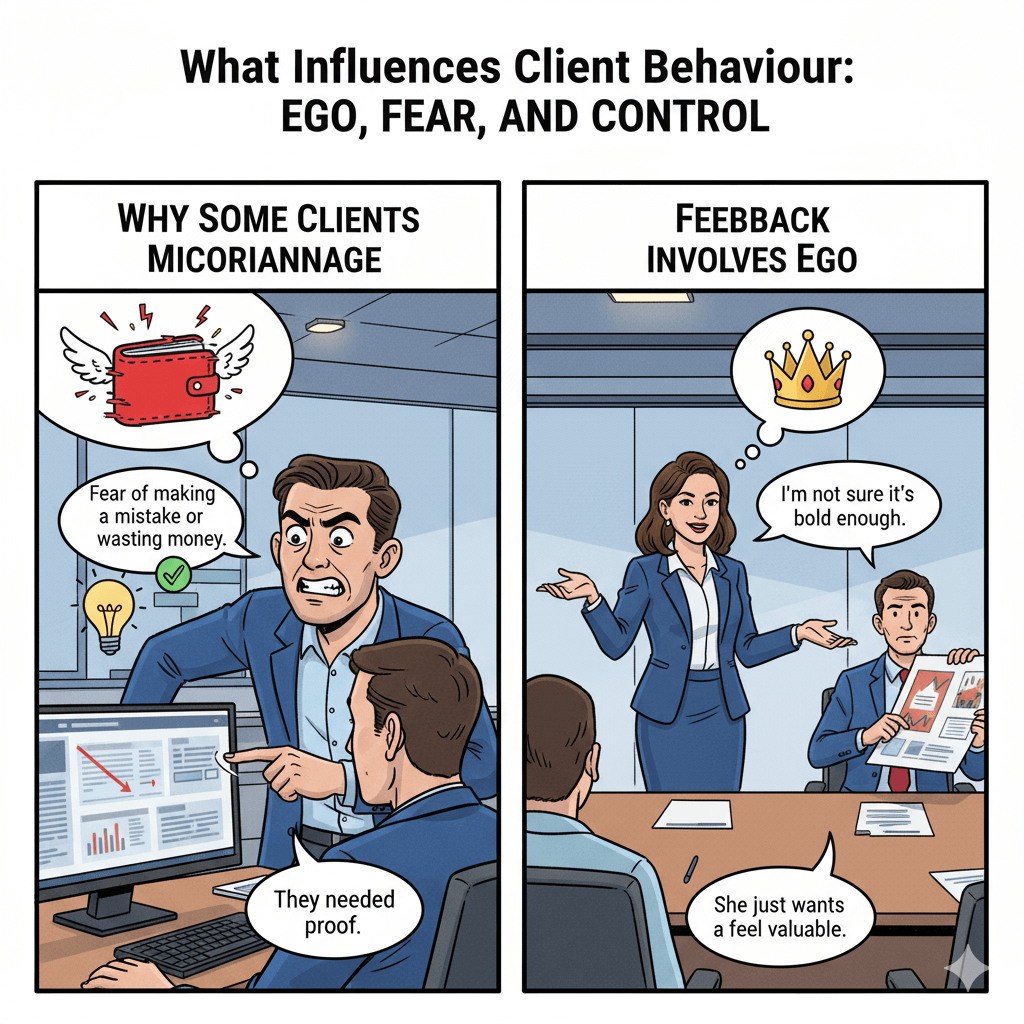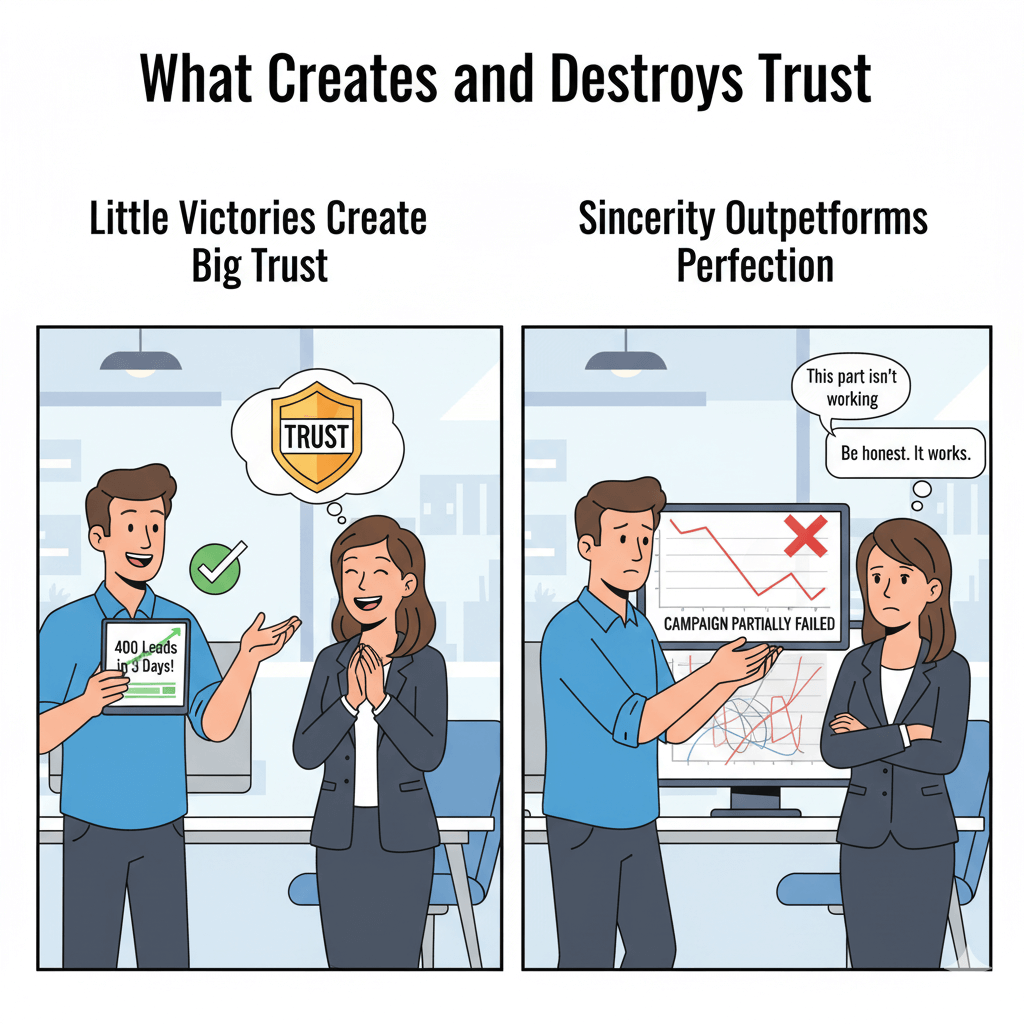A client abandoned me a few days prior to a significant campaign launch. Not a single update. No responses. After weeks of working on everything, all of a sudden there was nothing.
They said, “I panicked,” when they eventually returned. I wasn’t certain that I was prepared.
I still remember that moment. It made something click, not because the project was delayed.
Customers require more than just strategy. They must experience confidence, safety, and being heard.
Since then, I’ve collaborated with more than 50 brands, ranging from large corporations with multiple decision-makers to tenacious startups. I learnt something from each one about how clients trust, think, and make decisions.
This is what I’ve discovered.
1. The Early Signs: How Customers Communicate Their Identity to You
Real Tone vs. Email Tone
Some clients are brief and aloof in emails but friendly and talkative over the phone. The opposite is true for others. Consistency is more important than tone.
Expect conflicting signals later if a client sounds one way over the phone but entirely different in writing. Be mindful in advance.
Quick Responses vs. Prolonged Pauses
Some customers respond quickly. Others require days. Control is typically desired by quick responders. Silent types tend to consider their options carefully.
Silence does not necessarily indicate disinterest. Some clients just don’t talk much until they’re ready, but they watch everything.
The majority of clients scan proposals rather than reading them. They search for trust, prices, and deadlines.
One CMO once said, “Looks good,” in response to a 12-page proposal. When do we begin?
I learnt to keep things simple at that point. Avoid writing for other people’s approval. Write to ease the burden.
2. What Influences Client Behaviour: Ego, Fear, and Control

Why Some Clients Micromanage
Fear is often the root cause of micromanagement, fear of making a mistake or wasting money. Ego is rarely the issue.
Every post and line was examined by one client. It was draining. However, they retreated after I demonstrated some immediate outcomes. They required proof, not space.
People hesitate because they are afraid of losing money, especially early-stage founders. They want to make sure that every penny is working.
They will relax if you demonstrate a quick win early on, such as a strong ROI or positive feedback. Don’t strive for perfection. Strive for momentum.
Feedback Involves Ego
Feedback isn’t always about the work. The client wants to feel intelligent or in charge.
Someone may simply want to feel as though they contributed value when they say, “I’m not sure it’s bold enough.” Recognise the meaning behind the words.
3. What Creates and Destroys Trust

Little Victories Create Big Trust
A test ad that generated 400 leads in three days was the beginning of one of my greatest client relationships. They had complete faith in me after that.
You don’t have to give too much up front. Deliver a single, effective thing quickly.
Sincerity Outperforms Perfection
Customers don’t demand flawlessness. When something goes wrong, they want to know they can rely on you.
Saying “this part isn’t working, here’s why” has gotten better responses from me than acting like nothing is wrong. Be honest. It functions.
Narratives Are More Effective Than Statistics
Most clients forget your charts. However, they will remember if you say, “This advertisement made a homeowner feel proud enough to share their before-and-after photo.”
Data becomes human through stories. People relate to that.
4. How Psychology Influences Creative Work: Customers Want to Understand
They want you to “get it”—their goals, their mission, and their stress.
“This sounds like you listened,” one founder remarked. I learnt all I needed to know from that queue. Quality work is a personal matter.
Equalise Their Vitality Initially
Some customers move quickly and enthusiastically. Others are silent and cautious. Avoid using the same procedure on both.
A quiet thinker feels pushed by a loud pitch. A high-energy founder is produced by a slow process. Examine the space.
First Connection, Second Strategy
Metrics weren’t mentioned in my best pitch ever. “This is what most brands like yours struggle with emotionally,” I began.
That sparked an actual discussion. Later came strategy.
5. Putting Knowledge into Practice
Examine the Individual, Not Just the Synopsis
Keep an eye out for signs: Are they under stress? Do they know exactly what they want?
Otherwise, slow down. Improve the questions you ask. Don’t jump to conclusions.
Adapt Your Procedure to the Type of Client
| Client Type | What They Require to Feel Secure | Typical Triggers | Best Approach |
|---|---|---|---|
| Founder of a Startup | Flexibility, speed, and proof | Complexity and delays | Quickly demonstrate minor victories |
| Corporate CMO | Results, procedure, and clarity | Absence of structure | Give a detailed road map |
| Solo Brand Owner | Empathy and personal support | Feeling overlooked | Reflect back to them their objectives |
Recognise When to Take Charge and When to Back Off
Some customers want you to be in charge. Some wish to maintain control. You lose them if you push too hard with the wrong kind.
Knowing when to lead and when to step back is everything.
You Work With People, Not Just Brands
Here’s what I’ve observed after more than fifty brand deals: flawless strategy doesn’t always yield the best outcomes. They originate from genuine connections.
Clients aren’t just buying a service. They’re placing a wager on their intuition—that they’ll be well-understood, encouraged, and led.
If you focus on that, the rest falls into place.
Contact us at:
Book 1:1 Session with me for Digital Marketing Consultancy

FAQs
How can I tell if a client is prepared to commit?
They pose genuine queries. They discuss objectives in addition to cost.
Why do brand agreements fail?
Because customers lack clarity and confidence. Rarely is it about money.
How can I handle a client who is controlling?
Provide them with early updates. Provide evidence. Use structure to help them feel less anxious.
What happens if trust wanes in the middle?
Avoid avoiding it. Take responsibility for the issue. Make it obvious.
Why is psychology more important than strategy?
Because even in business, people make emotional decisions.
How can I modify my pitch for various customers?
Adapt their tone and tempo. Before you sell, pay more attention.
What is a warning sign that I should never disregard?
It’s a warning if they demand results without listening.
Will I ever lose a client?
Yes, but only if they lead to stress rather than growth.
If I make a mistake, how can I regain trust?
Be quick, truthful, and detailed about the solution.
Who achieves the best outcomes?
Customers who participate without being intrusive. They remain open and have faith in the process.




